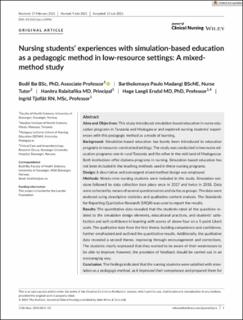| dc.contributor.author | Bø, Bodil | |
| dc.contributor.author | Madangi, Bartholomayo Paulo | |
| dc.contributor.author | Ralaitafika, Hanitra | |
| dc.contributor.author | Ersdal, Hege Langli | |
| dc.contributor.author | Tjoflåt, Ingrid | |
| dc.date.accessioned | 2021-08-23T18:19:27Z | |
| dc.date.available | 2021-08-23T18:19:27Z | |
| dc.date.created | 2021-08-23T12:51:51Z | |
| dc.date.issued | 2021-08 | |
| dc.identifier.citation | Bø, B., Madangi, B.P., Ralaitafika, H. et al. (2021) Nursing students’ experiences with simulation-based education as a pedagogic method in low-resource settings: A mixed-method study. Journal of Clinical Nursing | en_US |
| dc.identifier.issn | 0962-1067 | |
| dc.identifier.uri | https://hdl.handle.net/11250/2770826 | |
| dc.description.abstract | Abstract
Aims and Objectives
This study introduced simulation-based education in nurse education programs in Tanzania and Madagascar and explored nursing students’ experiences with this pedagogic method as a mode of learning.
Background
Simulation-based education has barely been introduced to education programs in resource-constrained settings. The study was conducted in two nurse education programs: one in rural Tanzania and the other in the mid-land of Madagascar. Both institutions offer diploma programs in nursing. Simulation-based education has not been included in the teaching methods used in these nursing programs.
Design
A descriptive and convergent mixed method design was employed.
Methods
Ninety-nine nursing students were included in the study. Simulation sessions followed by data collection took place once in 2017 and twice in 2018. Data were collected by means of several questionnaires and six focus groups. The data were analyzed using descriptive statistics and qualitative content analysis. The Standards for Reporting Qualitative Research (SRQR) was used to report the results.
Results
The quantitative data revealed that the students rated all the questions related to the simulation design elements, educational practices, and students’ satisfaction and self-confidence in learning with scores of above four on a 5-point Likert scale. The qualitative data from the first theme, building competence and confidence, further emphasized and outlined the quantitative results. Additionally, the qualitative data revealed a second theme, improving through encouragement and corrections. The students clearly expressed that they wanted to be aware of their weaknesses to be able to improve; however, the provision of feedback should be carried out in an encouraging way.
Conclusion
The findings indicated that the nursing students were satisfied with simulation as a pedagogic method, as it improved their competence and prepared them for professional practice. Further research is necessary to explore whether the students are able to transfer their knowledge into clinical practice. | en_US |
| dc.language.iso | eng | en_US |
| dc.publisher | John Wiley & Sons Ltd. | en_US |
| dc.rights | Navngivelse 4.0 Internasjonal | * |
| dc.rights.uri | http://creativecommons.org/licenses/by/4.0/deed.no | * |
| dc.subject | sykepleiestudenter | en_US |
| dc.subject | simuleringsbasert trening | en_US |
| dc.title | Nursing students’ experiences with simulation-based education as a pedagogic method in low-resource settings: A mixed-method study | en_US |
| dc.type | Peer reviewed | en_US |
| dc.type | Journal article | en_US |
| dc.description.version | publishedVersion | en_US |
| dc.rights.holder | (c) 2021 The authors | en_US |
| dc.subject.nsi | VDP::Medisinske Fag: 700::Helsefag: 800::Sykepleievitenskap: 808 | en_US |
| dc.subject.nsi | VDP::Samfunnsvitenskap: 200::Pedagogiske fag: 280 | en_US |
| dc.source.journal | Journal of Clinical Nursing (JCN) | en_US |
| dc.identifier.doi | 10.1111/jocn.15996 | |
| dc.identifier.cristin | 1928021 | |
| cristin.ispublished | true | |
| cristin.fulltext | original | |
| cristin.qualitycode | 2 | |

